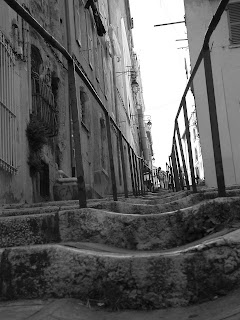There is more to this region than pastis, boules or medieval villages perched on hillsides. Fragrant lavender fields, beaches, gastronomical delights, festivals and yes, charming folk are all part of this sun kissed Mediterranean region.
Way back in June 2003, my friend Rosanne and I spent ten wonderful days touring Provence in our hired Renault Megane – whilst I provided my driving skills, Rosanne was instrumental in giving me the right directions to which ever village we decided to visit during that time.
Our itinerary started off from Marseilles, which is just a short, direct flight from Malta. Marseilles was previously a notorious city with a high crime rate but in recent years it has developed into a cosmopolitan city, offering a variety of sights sounds and smells to those willing to explore it on foot.
 Stairs leading to the Panier District, now a seedy district that during WWII had a strong Resistance presence and was heavily bombed by the Germans
Stairs leading to the Panier District, now a seedy district that during WWII had a strong Resistance presence and was heavily bombed by the GermansAlthough the western area of Marseilles is somewhat an eyesore due to rapid industrialisation in the past years, the southern tip can be described as France's most dramatic coastline - with a series of sharp ridged overhanging rocks known as Les Calanques (rocky inlets) leading on to the famed village of Cassis, which lends its name to wine produced there.
The harbour entrance is guarded by two Forts - on the southern side is the Fort St. Nicolas whilst just opposite one finds the Fort St. Jean which incidentally was founded in the 13th century by the Knights Hospitaller of St. John of Jerusalem.
 Bringing in the daily catch
Bringing in the daily catchShips have docked in the Vieux Port area for over twenty six centuries, and whilst the major commercial docks were moved to Joliette area, the Vieux Port remains an active area for pleasure yachts, fishing boats and ferries sailing towards the Chateau d’If.
The Chateau d'If was a fortress turned prison, built in the 16th century on a three hectare island and made notorious by Alexandre Dumas in his classic novel Le Comte de Monte Cristo.
 Seaview Accommodation on the Chateau d'If
Seaview Accommodation on the Chateau d'IfThe island prison, which is approximately 3.5kms away from the old port, was home to a number of political prisoners, revolutionaries,Communards of 1871and Protestants. Sailing to the island from the Vieux Port takes around 20 minutes and is quite a pleasant trip – that is if you are going to the island out of your own free will!
From a gastronomical perspective, no visit to Marseilles would be complete without tasting Bouillabaisse, a fish stew generally containing at least four different types of fresh fish cooked in a rockfish broth containing garlic, saffron, tomatoes, onions and herbs such as bay leaves, parsley and thyme. The secret of Provencale cooking does not lie in elaborate preparation techniques but the use of fresh ingrediates used and grown locally.
 Photos Copyright Maria Vella-Galea 2003
Photos Copyright Maria Vella-Galea 2003










